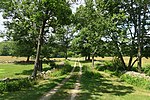Milford Town House and Library Annex
Buildings and structures in Hillsborough County, New HampshireCity and town halls in New HampshireCity and town halls on the National Register of Historic Places in New HampshireItalianate architecture in New HampshireLibraries on the National Register of Historic Places in New Hampshire ... and 5 more
Library buildings completed in 1870Milford, New HampshireNational Register of Historic Places in Hillsborough County, New HampshirePublic libraries in New HampshireSecond Empire architecture in New Hampshire

The Milford Town House and Library Annex, now just the Milford Town Hall, is a historic municipal building occupying a prominent position facing the central oval in Milford, New Hampshire. Built in 1869-70 and enlarged in 1891, it is the only known surviving work of architect Gridley J. F. Bryant, and is a significant local example of Italianate and Second Empire architecture. The building was listed on the National Register of Historic Places in 1988.
Excerpt from the Wikipedia article Milford Town House and Library Annex (License: CC BY-SA 3.0, Authors, Images).Milford Town House and Library Annex
Elm Street,
Geographical coordinates (GPS) Address Nearby Places Show on map
Geographical coordinates (GPS)
| Latitude | Longitude |
|---|---|
| N 42.835555555556 ° | E -71.649444444444 ° |
Address
Elm Street 285
03055
New Hampshire, United States
Open on Google Maps








